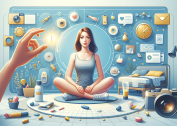In our busy lives, finding time for creativity can be a challenge. Nonetheless, cultivating creative hobbies not only offers a much-needed escape from daily stress, but it also helps with problem-solving, innovation, and even boosting mental health. Whether you’re an artist at heart or just looking to spark your imagination, there are several emerging trends in creative hobbies that can fit any lifestyle. In this article, we’ll explore the top 5 hobbies to develop creativity.

1. Digital Art: From Drawing to Animation
Digital art is a booming field that allows you to express your creativity using technology. To begin, you can start with simple digital drawing tools like Procreate or Adobe Illustrator, and as you progress, explore more advanced areas like 2D or 3D animation. Moreover, digital art offers flexibility, allowing you to edit and refine your work, providing endless opportunities for creativity and growth
Why it’s great for creativity:
You can explore a wide range of artistic styles, from sketching to full-fledged animation.
Digital platforms provide flexibility—you can create and edit with ease, without worrying about traditional art supplies.
It’s highly accessible; all you need is a tablet or a computer.
Practical Tip:
Start with basic tutorials on YouTube or enroll in online courses like Skillshare or Udemy to learn digital drawing and animation. With these platforms, you can find structured lessons to guide your progress.
2. Photography: Capture the World Differently
In addition, photography is not just about snapping pictures—it’s about finding beauty in the ordinary and expressing your unique perspective. With the rise of smartphone cameras and advanced photography apps, this hobby has become accessible to anyone. Furthermore, photography encourages experimentation with lighting, composition, and color, helping you tell unique stories through imagery. It also promotes mindfulness and observation skills, helping you see the world from new angles. For example, combining photography with travel blogging or product design can enhance your creative expression.
Practical Tip:
Use apps like VSCO or Lightroom to edit your photos and experiment with filters, exposure, and contrast. Try out photo challenges that push you to capture specific themes like architecture, nature, or portrait photography.
3. Writing: Blogging, Journaling, and Storytelling
Writing remains one of the most powerful ways to express creativity. Whether you’re crafting stories, documenting personal experiences, or starting a blog, writing is an excellent way to develop imagination and self-expression. Additionally, it fosters reflection, encourages deep thinking, and enables you to communicate complex emotions or ideas. Writing takes many forms, including creative writing, poetry, journaling, or blogging on subjects you’re passionate about. As a result, it helps improve focus and clarity of thought.
Practical Tip:
Try setting aside 15 minutes a day for free writing, or start a themed blog where you can explore your interests, such as food, travel, or photography.
4. DIY Crafts: Get Hands-On with Your Creativity
DIY (Do-It-Yourself) crafting is another creative outlet that allows you to make everything from home decor to personalized gifts. With platforms like Pinterest and Etsy, inspiration is just a click away. Furthermore, this hobby can easily turn into a small business venture if you decide to sell your handmade items. DIY crafting encourages you to experiment with materials like clay, wood, or fabric, stimulating both mental and tactile creativity. Importantly, DIY projects promote sustainability and resourcefulness by encouraging upcycling.
Practical Tip:
Start small—consider projects like making scented candles, pottery, or simple home decorations. You can find DIY kits online that contain all the materials and instructions you need to get started.
5. Music Production: Create Your Own Sound
Finally, music is a powerful form of expression. Thanks to digital platforms, expensive instruments or studios are no longer necessary to create music. Whether you’re mixing beats, playing an instrument, or writing songs, music production allows you to create soundscapes that reflect your emotions. Moreover, it combines technical and creative skills, offering endless possibilities for experimentation. Music production also encourages collaboration, leading to a rich exchange of ideas and techniques, while improving concentration, multitasking, and patience.
Practical Tip:
Start with simple music production software like GarageBand (for beginners) or Ableton Live (for more advanced users). Focus on creating simple beats or melodies and gradually explore more complex arrangements as your skills improve.
Conclusion
These five hobbies—digital art, photography, writing, DIY crafts, and music production—are perfect for anyone looking to develop their creative side. Firstly, not only do these activities help you tap into your artistic potential, but they also provide significant stress relief. Additionally, these hobbies can even become profitable ventures over time. Whether you choose to create digital art, craft with your hands, or express yourself through music, ultimately, these hobbies offer something for everyone.
References:
1. Skillshare – “How to Make Digital Art: A Complete Guide”.
2. Art One Academy – “Cultivating Creativity: Benefits of Digital Art”.
3. I Love IT – “Digital Art as a Passion”.









